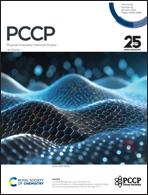Relaxor ferroelectric-like glassy dielectric dispersion in the triple perovskite Ba3CoSb2O9
Abstract
In this work, the dielectric response of polycrystalline Ba3CoSb2O9 was studied as a function of temperature (30 to 900 °C) and frequency (10 Hz to 10 MHz). The triple perovskite Ba3CoSb2O9 was successfully synthesized and characterized for structural and dielectric properties. The Rietveld analysis of the X-ray diffractogram confirms the formation of a hexagonal phase with P63/mmc symmetry. This centrosymmetric 3(BaCo1/3Sb2/3O3) perovskite shows structural similarity to a prototypical non-centrosymmetric relaxor ferroelectric, PbMg1/3Nb2/3O3. The dielectric constant, ε', follows a non-Debye Cole–Cole relation and exhibits anomalous responses such as: (a) a thermally activated colossal dielectric constant (>105) and (b) a highly dispersive peak maximum (523–853 K). The real part of ac conductivity, σ′, also shows a change of approximately 6 orders in magnitude (10−8 to 10−2 S m−1). Validation of Jonscher's law and impedance (Nyquist plot) and modulus (M′′) analyses indicate that hopping polarization is the predominant thermally activated mechanism. Moreover, the large value of ε′ and its dispersion were found to be highly correlated with the underlying crystal structure and were attributed to the local ionic site ordering. The study suggests that the anomalous dielectric dispersion must have an intrinsic origin.



 Please wait while we load your content...
Please wait while we load your content...